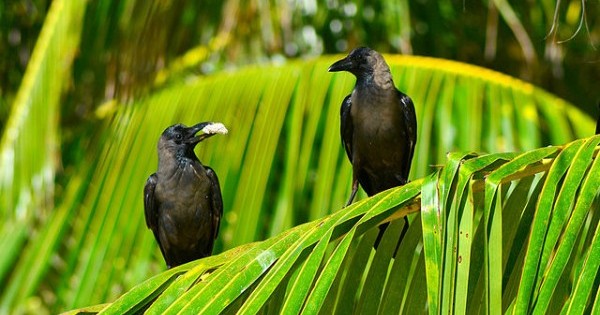
Yesterday’s crow was a lone bird on a wire. Solitary crows are an illusion of course because crows are not loners. It was black-beaked, black-feathered, glossy, big. It cawed in sequence six times, then four times, then six times. Each caw was accompanied by a bird-type shrug, a lifting of the upper part of the wings without moving the wingtips, as if to air his (her?) wingpits. Crow talk involves at least 30 types of caws, chortles, croaks, coos, clucks, and screams. Add body language and you’ve got language, according to John Marzluff and Tony Angell (In the Company of Crows and Ravens). Or anyhow, you have crow language.
Crows are everywhere around here (Seattle). I believe they are everywhere around everywhere. I like to think I’m a friend to crows but I fear the feeling is not mutual. Our inter-species relations got a bit strained when, a while back, I was standing at a curb waiting to cross and a crow on a wire dropped a stone on my head. My kind feelings were further strained at the sight of a crow flapping off with a baby robin in its beak, the nestling’s mother in futile, distressed pursuit. This sad scene intruded upon my wait at a bus stop.
Their predation on nestlings is one reason some people hate crows. Yet crows also eat roadkill, crickets, maggots, worms, and mice. Crow depredations on other birds are nothing compared to those of domestic cats. Domestic cats kill hundreds of millions of songbirds per year. (Songbird advocates believe that cats should live indoors.) Yet how often do we hear rants against cats?
Crows are songbirds (yes they are). They are members of the order Passeriformes along with warblers, finches, and sparrows, all perching birds with three forward-facing toes and one backward-facing toe. Crows are members of the family Corvidae—crows, jays, magpies, ravens. The Corvidae are the brawling family, the one that dive-bombs, mobs, and commits riots.
The crows that inhabit my neighborhood (or is it their neighborhood?) are the American crow, Corvus brachyrhynchos. Look up at dusk and you’ll see dozens of them flying eastward toward their roost. Crow roosts can contain thousands or even a million or more individual birds. (A 1972 census of a winter roost in the Fort Cobb area of Oklahoma counted 2,108,903 crows.)
Around here, night is quiet, but dawn is blasted into being by that coarse caw caw caw caw.
Crow hatred is common but untoward. Crows are brilliant. (If you don’t believe it, read “The Mentality of Crows: Convergent Evolution of Intelligence in Corvids and Apes,” by Nathan J. Emery and Nicola S. Clayton, in Science magazine.) Crows shield their young and will dive-bomb anyone anywhere near a nest. They recognize and remember human faces (for life), and since they detest being banded, researchers who band crows wear masks.
Crows play. One of their games is to fly up with a stick, drop it, dive for it, and catch it before it hits the ground.
They live in monogamous pairs; family groups include a helper or two, usually last year’s fledglings. This gang sets out each dawn to forage for food, returning to the roost at dusk. Crows take care of other crows, tend their wounded, teach their young. The mating pair allopreens (pecks through each other’s feathers much as chimps pick through each other’s fur). Crows coo and fuss over their Chosen One, and they mob predators (owls, raccoons, hawks).
Crows have survived. They have lived on Earth for several million years, far longer than we have. Some sacred traditions consider crows to be emissaries from the spirit world, messengers soaring back and forth over the River Styx.
To me they are at least that mysterious.

